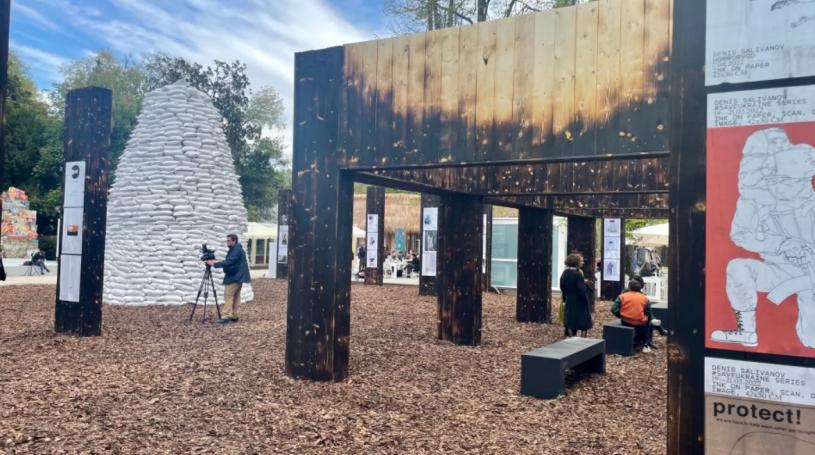Venice Biennale erects scorched temporary 'pavilion' for Ukraine in the middle of the Giardini
The "meditative" space aims to put Russia's war in Ukraine at the heart of the exhibition—and at the forefront of peoples' minds
A large wooden structure is smouldering in the middle of the Giardini section of the Venice Biennale. A temporary "pavilion" (or piazza) for Ukraine is being erected in the area as VIPs and members of the press descend on the Italian city for the first preview day of the exhibition (23 April-27 November). The pergola-like building has been built in a throughfare of the Giardini, close to the café and in front of the US pavilion, to bring the plight of Ukraine to the heart of the Biennale.
Made of a light wood, a team is scorching the surface using a blow torch. “The technique looks violent, with fire,” says Dana Kosmina, the Ukrainian architect of the project, who herself fled Kyiv at the start of the Russian invasion. “But it makes the wood stronger and protects it from the environment—which is symbolic of the war in Ukraine.”
Kosmina says that the Venice Biennale team came up with the idea to give a prominent space to Ukraine only two weeks ago. Although Ukraine has a national pavilion, it is located away from the main Biennale area. The temporary project in the Giardini, created by Kosmina and the turators of the Ukrainian Pavilion, Borys Filonenko, Lizaveta German, Maria Lanko, aims to put Ukraine in a more prominent position and at the front of the art world’s minds. “It is meant to be a meditative space,” Kosmina says.
Dark bark chips mark the area of the pavilion: within it sits the pergola, a mountain of sandbags, and several scorched totems that are covered in posters featuring Ukrainian art. “The posters will be changed every few weeks,” Kosmina explains. The several-metre-tall sandbag monument represents the heritage sites currently being protected by locals in Ukraine; community groups have worked together to cover statues in sandbags to limit the damage being inflicted by Russian attacks.
The Venice Biennale team released a statement on 2 March condemning Russia’s military aggression. “La Biennale di Venezia intends thereby to manifest its full support to the Ukrainian people and to its artists,” it stated. The temporary structure is entirely funded by the Biennale.
Despite the extreme difficulties, the official Ukrainian pavilion has successfully opened with the work Fountain of Exhaustion by the artist Pavlo Makov, an updated version of a 1995 sculpture. Meanwhile, the Russian pavilion—only metres away from the new temporary structure—remains closed, watched over by a lone security guard.

